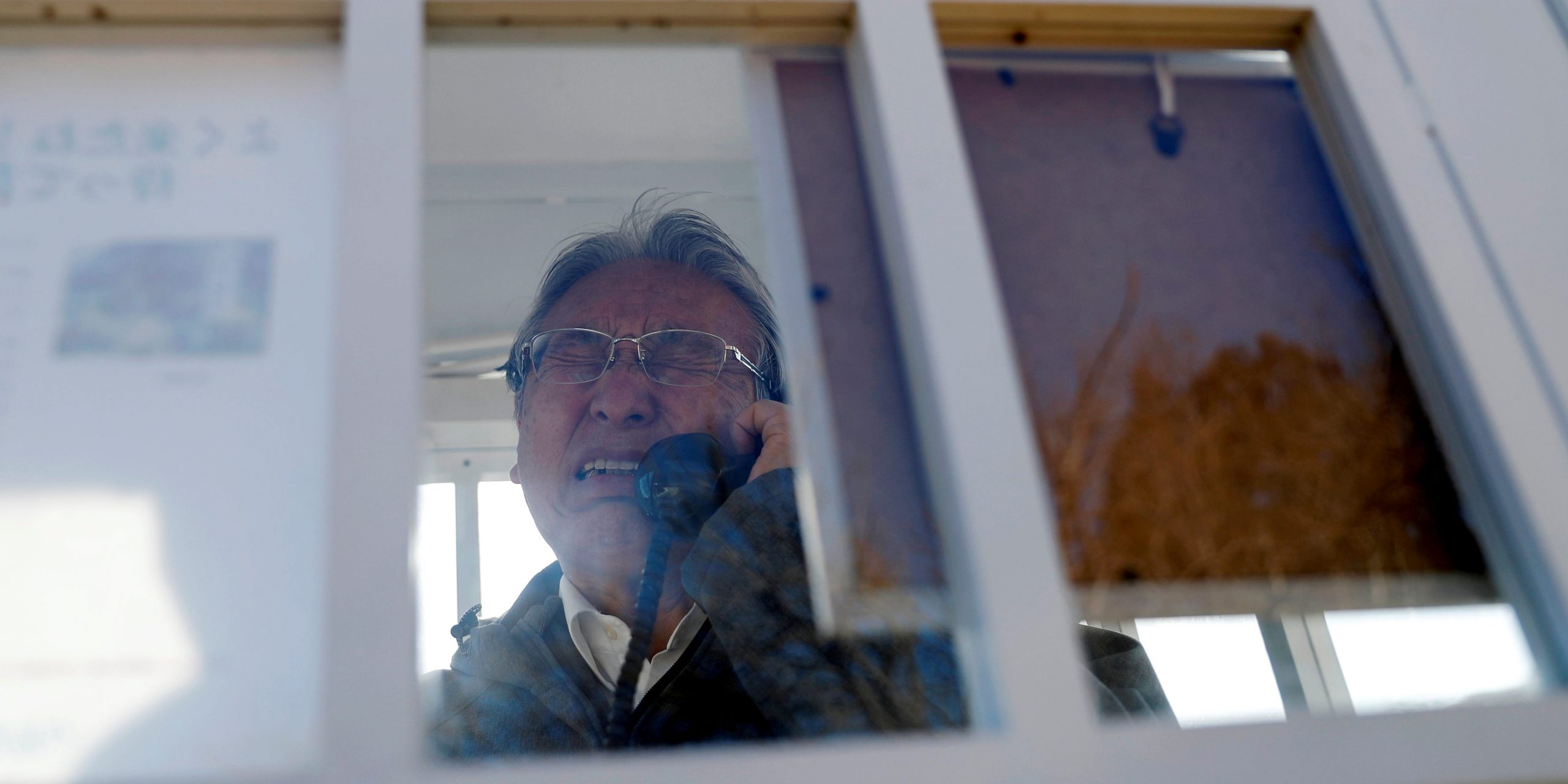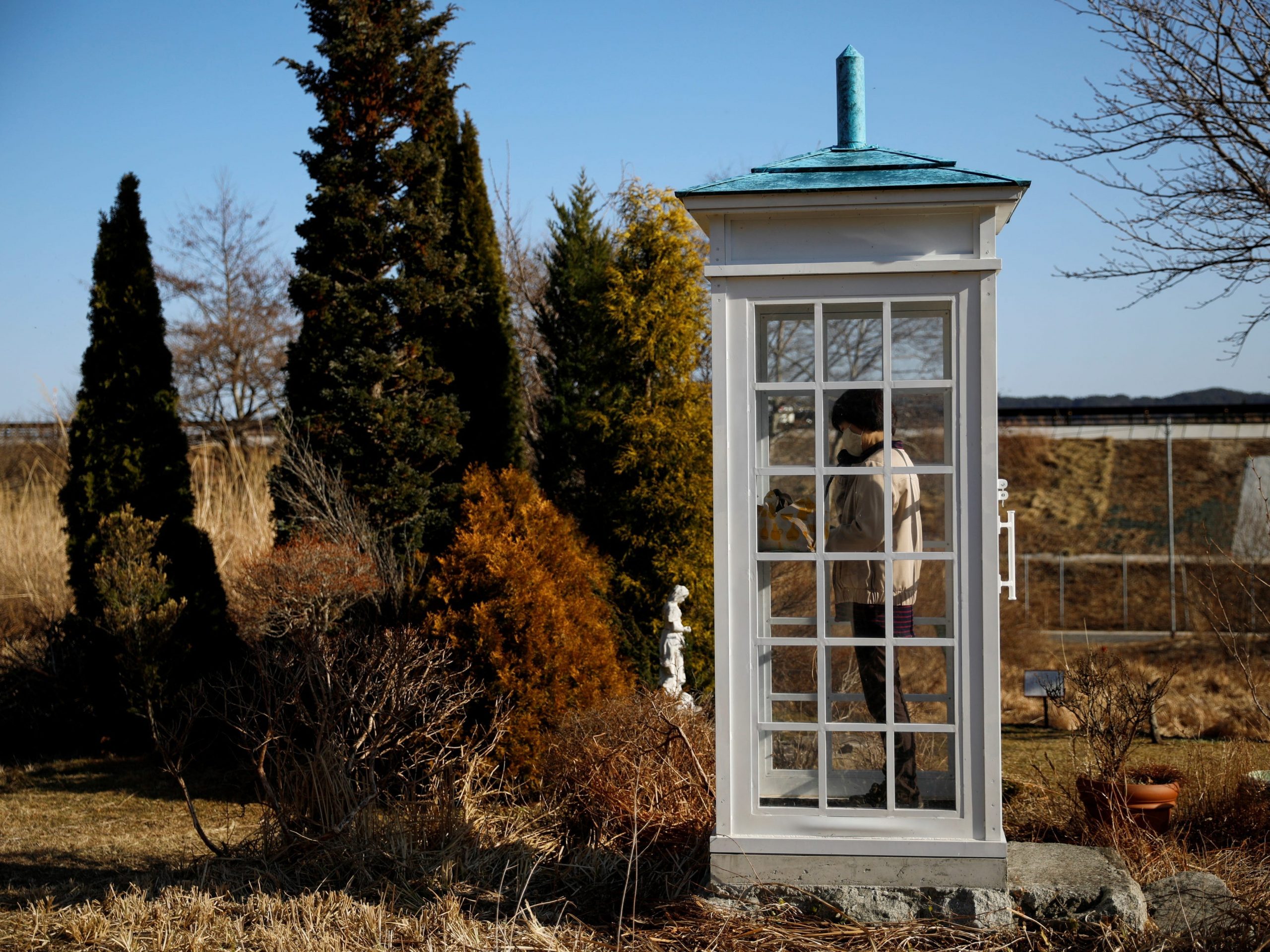
Issei Kato/Reuters
- The Kaze no Denwa (or "phone of the wind") is for some the last connection they have to deceased loved ones.
- Survivors of the 2011 Tohoku earthquake and tsunami have made pilgrimages to the phone booth over the last decade.
- The phone booth was set up by 76-year-old Itaru Sasaki, who built it after the death of his cousin.
- Visit Insider's homepage for more stories.
In the town of Otsuchi, located in Japan's Iwate Prefecture, a lone phone booth stands on a windy hillside, its pristine white frames shimmering in the morning light. The booth contains precious little other than an old black rotary-dial telephone, its brass buttons dull and worn from the years of dialing.
This is the Kaze no Denwa (or the "phone of the wind"). For some survivors of the 2011 Tohoku earthquake and tsunami that set off the Fukushima nuclear disaster, it is the last connection they have to their loved ones.
The "phone of the wind" is an unconnected phone booth built in 2011 by garden designer Itaru Sasaki, 76. It sits on a hillside with a breathtaking view of the calm Otsuchi shoreline and exists as a place for people from Otsuchi and other affected communities in northern Japan to come to seek solace and process their grief. Sasaki constructed the booth in his garden after the death of his cousin.
He told the Japan Times the phone booth has seen thousands of visitors over the last decade, including those who lost loved ones to suicide and illness.
Otsuchi, located on the Sanriku coast around 300 miles north of Tokyo, was devastated by the March 2011 tsunami and earthquake. It is estimated that around 10% of the town's population – around 1,285 people – died or went missing in the disaster.
Inside the phone booth are notes handwritten by visitors, along with framed poems. One reads:
"Who will you call, on the phone of the wind? When you hear the wind, speak to them from your heart. Tell them how you feel, and your thoughts will reach them."
In a video earlier this year, Reuters spoke to Kazuyoshi Sasaki, 67, who made a pilgrimage to the booth to call his late wife Miwako's cell number.
Miwako was one of nearly 20,000 people in northeastern Japan killed in the disaster on March 11, 2011.
"It all happened in an instant. I can't forget it even now," he said while in the phone booth. "I sent you a message telling you where I was, but you didn't check it."
"When I came back to the house and looked up at the sky, there were thousands of stars. It was like looking at a jewel box," he continued. "I cried and cried and knew then that so many people must have died,"
Sasaki told Reuters that he had first confessed his love to Miwako when they were in junior high, and she rejected him. But ten years later, they began dating and eventually married and had four children.
"I'll take care of myself," he said, before hanging up. "I'm so glad we met, thank you. Talk soon."
In early March, Japan's NHK network released "The Phone of the Wind: Whispers to Lost Families," a documentary on the phone booth. The film was nominated for an International Emmy Award for Best Documentary.
In it, filmmakers spoke to Ren Kozaki, 15, a teenager who journeyed alone for four hours from his home in Hachinohe to talk to his late father in the phone booth. Kozaki lives in the small city in Aomori, near the northernmost tip of Japan, with his 12-year-old brother Riku, his 14-year-old sister Rin, and his mother, Hitomi.

Issei Kato/Reuters
Kozaki's father, Kazuhiko Kozaki, worked as a truck driver and was plying a newly-assigned route off the coastal town of Ofunato when the tsunami hit.
"Hey, dad. Are you doing okay? We're doing the best we can, so don't you worry," Kozaki says in the film, clutching the phone.
"Why did you have to die? Why can't we find you?" he asks. "I wanted to ask you this. I wanted to talk to you one last time."
Sasaki told the Japan Times he's been approached by parties who want to set up similar phone booths in the UK and Poland, who want to help people "call" the loved ones they lost in the COVID pandemic.
"There are many people who were not able to say goodbye. There are families who wish they could have said something at the end, had they known they wouldn't get to speak again," he said.
Sasaki's book about the project, titled "Kaze no Denwa - Daishinsai Kara Rokunen, Kaze no Denwa wo Tooshite Mieru Koto (The phone of the wind - what I have seen via the phone in the six years since the earthquake)," has since been published in Japan by publisher Kazama Shobo.